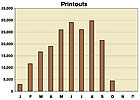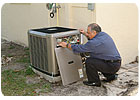
Cameron is the president of HVAC Sellutions, a company he describes as "a network of innovative companies that provide unique products and services to HVAC, IAQ, and plumbing contractors. The concept results in contractors receiving customized solutions to fit their specific needs from the industry's and professional sales' greatest minds."
Cameron said that offering the matched system certificates from the Air-Conditioning and Refrigeration Institute (ARI) helps "differentiate ourselves and eliminate competition." Manufacturers actively promoting the use of the certificates include WaterFurnace International and Lennox, as well as a number of distributors.
Table 1 shows the number of certificates being printed out each month from ARI's Directory of Certified Product Performance, which launched at the end of January 2006, said the institute's Colleen Hughes. "In just a three-month period (June through August 2006), 90,000 certificates were printed from ARI's directory," she said. "That's 30,000 certificates each of those months.
"It mirrors the increase in unitary a/c and heat pump shipments we see during that time of year as well," she added.

CERTIFIED PERFORMANCE
The certificates verify that the indoor unit and condensing (outdoor) unit of a unitary system are appropriately matched. This ARI "Certificate of ARI-Certified Performance" indicates that the system is an ARI Performance Certifiedâ„¢ system. "It ensures homeowners that the product they purchased will perform as stated by the manufacturer," William Sutton, president of ARI, said.Homeowners have also been encouraged to check to see if their system is matched by using the ARI Directory of Certified Product Performance, where they can input the model numbers of their indoor and outdoor units to find out if it is a matched system.
Contractor interest in the certificates is already high, and it is continuing to grow. "We talked about offering the certificates in September," James Kester, Colonial Plumbing and Heating Co., Colonial Heights, Va.
It's one more tool against competitors who are taking installation shortcuts.
"Purchasing a new system is something many homeowners don't often do since most systems last 15 to 20 years, which is why they look to our organization for guidance," said Sutton. "A new system is a significant investment and a long-term commitment, which is why it is important to find a qualified technician and the right system to meet your indoor comfort needs."
TIPS FOR A QUALITY INSTALLATION
ARI also offered the following tips for homeowners:
It even explained the concept of measuring for superheat and subcooling, though not exactly in those terms. "To properly size a system for a home, trained technicians will use an equation that factors the home's age, the number and quality of its windows, how well it is insulated, how many stories it has, its total square footage, and local energy rates," Sutton explained.
"Homeowners should ask their technicians to perform a Model J, the industry's term for the standardized equation for sizing."
ARI went on to explain that while some air conditioning systems already use replacement refrigerant R-410A, at the present time homeowners can still purchase systems using R-22. Moreover, Sutton elucidated, "R-410A cannot be used in a system designed to use R-22 because this new refrigerant requires about 50 percent more pressure to work effectively. For homeowners choosing R-410A systems, they must replace the outdoor and indoor units, otherwise their systems will fail."

HOW ABOUT THOSE TAX CREDITS?
Finally,Sutton pointed out that this year, homeowners installing a 15 SEER split air conditioning system, or a 14 SEER package system, are eligible for a $300 federal tax credit.Air-source heat pumps also are eligible for a $300 federal tax credit if they have a 9 HSPF, 13 EER, or 15 SEER. "Homeowners also should check with their local utility companies to find out if they offer rebates to purchasers of energy-efficient indoor comfort systems," said Sutton.
For tax purposes, homeowners should save their receipts and Manufacturer's Certification Statements, Sutton pointed out. A Manufacturer's Certification is a signed statement from the manufacturer certifying that the product or component qualifies for the tax credit. "The IRS encourages manufacturers to provide these certifications on their Websites to facilitate identification of qualified products," said ARI. "Taxpayers must keep a copy of the certification statement for their records, but do not have to submit a copy with their tax returns."
For more information, visit www.ari.org, www.aridirectory.org, and www.natex.org.
Publication date: 11/27/2006

Report Abusive Comment